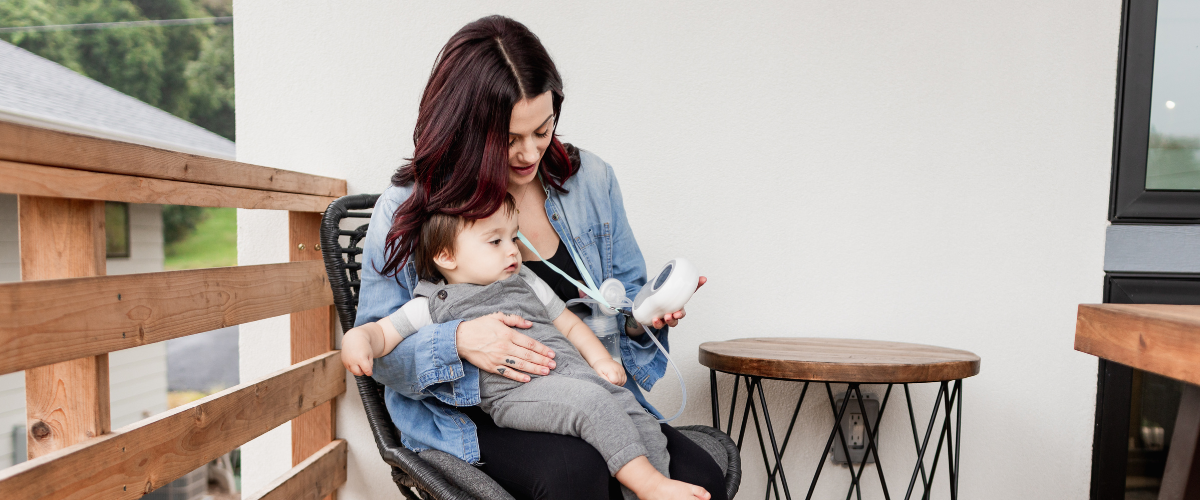Breastfeeding Goals
With all the encouragement to breastfeed for its nutritional, health, and bonding benefits for both mother and baby, the next question may be, “OK, but for how long?” This commitment can be daunting, especially with obstacles and no end in sight when it feels all-consuming. We have the “shoulds” and the evidence-based research to back things up, but let us also discuss the nuances, the plan to get to the goal, and the tools to incorporate into your lifestyle to help get you there.
In this blog:
- What does the evidence suggest?
- How to set a goal as an individual
- Forming a plan with the right tools
What Does The Evidence Suggest?
Regardless of preferences, goals, or intentions, babies have to have breastmilk, formula, or both, for the first full year of life as their main source of nutrition. Calories will also come from introductions to solids (baby food, soft table food, etc.) in due time, but it hardly covers the caloric intake needed to fulfill needs on their own. This should be treated as complementary and as a nutritional supplement during the first year.


This means the first long-term goal for breastfeeding is one year, based on nutritional and caloric needs.
Other metrics for breastfeeding duration include immune system development, emotional support, and maternal health benefits. The overarching theme: the longer, the better.
The World Health Organization (WHO) and the National Institute of Health (NIH) both recommend providing breastmilk for a minimum of at least two years. Based on numerous articles and research showing short-term and long-term benefits to the immune system and physiological responses to illness or contraction.
From the beginning with colostrum, with its leukocytes, antibodies, and intestinal pH balancing effects, to the real-time antibody adaptation throughout the entire breastfeeding journey, to the long-term protection of the gut lining for its maturation process (2 years), breastmilk and breastfeeding mechanisms are crucial for an optimal immune system development that sets the tone for the rest of their life.¹
Protection against infections has been well evidenced during lactation against, e.g., acute and prolonged diarrhea, respiratory tract infections, otitis media, urinary tract infection, neonatal septicemia, and necrotizing enterocolitis. There is also interesting evidence for enhanced protection remaining for years after lactation against diarrhea, respiratory tract infections, otitis media, Haemophilus influenzae type b infections, and wheezing illness. In several instances, the protection seems to improve with the duration of breastfeeding. ²
Duration is particularly important in maternal health, as it prolongs the return of menses, and drastically reduces the presence of free estrogen. When menses, period cycles, and takes a long break, the body can replenish iron and calcium stores, which is dramatically tapped into after years of having a period, and certainly after growing another human. Bone density is vastly improved, and that has been shown in the decreased rates of osteoporosis with the numbers related to breastfeeding duration.
With free estrogen at bay, risks for related female cancers are reduced to a point of surprising rate- with a cumulative duration of 7 years or more of breastfeeding, the mother has 0 percent chance of breast or ovarian cancer diagnosis, with every year building up to that amount plummeting the risks. No other health initiative has been able to claim that. To be clear, this is a cumulative amount, meaning this 7-year amount can be achieved through multiple offspring or one. But don’t forget EVERY DROP COUNTS:
For a single breastfeeding episode, a mean breastfeeding duration of 1 to 3 months was associated with 18% lower risk.³
How To Set a Goal As An Individual?
Evidence aside, the reality is that life has a unique path, and today’s world isn’t necessarily a woman’s best friend, so nature’s design often takes a backseat. However, we can use this to frame our goals. Much like we know we should eat our vegetables and exercise, we take our intentions and sustainably implement them- so we stick with something! We need to look at the long-term goals and dissect them into smaller, digestible ones so that the bigger picture isn’t overwhelming. Ultimately, as an individual, you get to have a say, and can form these plans based on educated decisions, rather than judgments and “shoulds.”
Long Term Goals
Six Months- to meet minimum exclusivity (no water, solids, or supplement)
One Year- to meet minimum caloric requirements
Two Years - to meet immune system/gut maturity
Seven Years (or amount to cumulative goal) - counting toward 7-year preventative health goals
Short Term Goals
1 Day: Adjust to the learning curve of frequent colostrum feeds and immediate obstacles. Think back to breastfeeding class information.
3 Days: Mature milk comes in, addresses sleepy baby obstacles and engorgement
2 weeks: Sleepy days and long nights, the first true cluster feeding stage happens, passing the window for “breastfeeding jaundice”
1 month: overcoming feeding problems, meeting weight regain goals in baby, addressing any latching issues, and correcting
3 months: assessing milk supply, gearing up for cluster feedings and growth spurts, the possibility of returning to work from maternity leave, implementing pumping routines
6 months: slow introductions to soft solids or baby food, sips of water, still breastfeeding full time, how is pumping going?
9 months: Experiencing teething and how to correct it, assessing how you feel about continuing?
12 months: Introducing more substantial meal portions, cups of water, or diluted juice, feedings feel much more spaced out and sustainable. Reassess long-term goals and feelings about them.
This structure is an example of average experiences through the first year, and certainly not all-encompassing, but allows you to see what to reflect on, give grace and understanding for, and pace it in a way that feels good when you reach that milestone and take away that sense of “forever breastfeeding,” which doesn’t feel autonomous, or pleasant, for many.
Forming a Plan With The Right Tools
Having goals and intentions is only half of the picture. Breastfeeding can be an enjoyable, sustainable journey with the right “tools in the toolbox.” From forming a plan to carrying it out with adequate resources, support, and equipment, let’s break down how to put it into action.
Support
Support, or rather lack thereof, is the number one reason for cessation of breastfeeding. It is not latching issues or low milk supply that takes this number one spot.
Resources and support come in many forms. Some may prefer written literature of books and blogs, YouTube tutorials, and testimonials, while others need in-person support and help. Regardless of the preferred medium, opt for evidence-based sources with the right training: IBCLCs. International Board Certified Lactation Consultants, like yours truly, strive to provide the tools you need without the fluff and myths that float about, which can make things worse, or at least confusing.
Support also comes from your environment. They say it takes a village, so make sure your village is one with the right intentions for you. Friends and family can make or break your journey, so voice your wishes, and enforce your boundaries, as needed.
Therapy can be a priceless tool. Most moms experience feelings of blue, overwhelmed, or frustrated at some point, though perhaps at different potencies. Untangle your thoughts, and get things off your chest with someone who will be there to give unbiased tools and reminders to be kind to your brain. The Canopie App has many resources to help moms manage stress as you care for yourself and your little ones. They believe every mother should have access to effective mental health care.


WIC is near and dear to my heart as a community health resource, extensively trained to support breastfeeding women, including setting goals. From community resource lists to incentive food packages to aid the family, be sure to check for qualifications.
Equipment
Equipment will look different from each journey, too. For some, it is just a good pillow to help with positioning through feeds. For others, it is the whole package of state-of-the-art pumping equipment, milk storage, and hands-free gadgets for the busy mom.
Time management is a huge obstacle so many face, even with the best intentions or experiences, we are coming up with more and more ways to be autonomous with our goals, no matter what life throws at us. For instance, hands-free pumping has made leaps and bounds with its design and abilities and can be the very thing needed to maintain supplemental pumping schedules while super moms tackle their day.
Think about your goals, what plan you have to reach them, and what you need to make those happen. Ultimately, your efforts are never in vain, and remember when it comes to you and your baby, every drop counts
1. Camacho-Morales A, Caba M, García-Juárez M, Caba-Flores MD, Viveros-Contreras R, Martínez-Valenzuela C. Breastfeeding Contributes to Physiological Immune Programming in the Newborn. Front Pediatr. 2021;9:744104. Published 2021 Oct 21. doi:10.3389/fped.2021.744104
2. Hanson LA. Breastfeeding provides passive and likely long-lasting active immunity [published correction appears in Ann Allergy Asthma Immunol 1999 May;82(5):478]. Ann Allergy Asthma Immunol. 1998;81(6):523-537. doi:10.1016/S1081-1206(10)62704-4
3. Babic A, Sasamoto N, Rosner BA, et al. Association Between Breastfeeding and Ovarian Cancer Risk. JAMA Oncol. 2020;6(6):e200421.
doi:10.1001/jamaoncol.2020.0421
Information provided in blogs should not be used as a substitute for medical care or consultation.







